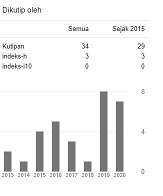THE EFFECTIVENESS OF TPRC STRATEGY FOR TEACHING READING COMPREHENSION OF DESCRIPTIVE TEXTS
Abstract
Keywords
Full Text:
PDFReferences
Anderson, M. and Anderson, K. 1997. Text Type in English 2. Macmillan: South Yarra
.
Brown, H. D. 2004. Language Assessment: Principles and Classroom Practices. New York: Pearson Education Limited.
Carnine, D., J. Silbert, and E. J. Kameenui. 1990. Direct Instruction Reading. Ohio: Merril Publishing, Co.
Celce-Murcia, M. 2001. Teaching English as a Second or Foreign Language. Boston: Heinle & Heinle.
Freeman D. and Richard. Teacher Learning in Language Teaching. Cambridge: Cambridge University Press.
Grabe, W and FL. Stoller. 2002. Teaching and Reading. London: Longman.
Haris, Albert J; Edward R, Sipay. 1980. How to Increase Reading Ability. New York: Longman Inc.
Hornby, A.S 1995 Oxford Advanced Dictionary of Current English. London: Pearson Education Ltd.
Nunan, D. 1989. Designing Task for the Communicative Classroom. Cambridge: Cambridge University Press.
Nuttall, C. 1996. Teaching Reading Skills in a foreign language (New Edition).Oxford: Heinemann.
Russell Gersten, Lynn S. Fuchs, Joanna P. Williams, and Scott Baker. 2001. Teaching Reading Comprehension Strategies to Students With Learning Disabilities: A Review of Educational Research; vol. 71, 2: pp. 279-320
Rudell, Martha Rapp. 2005. Teaching Content Reading and Writing. USA: Wiley Jossey-Boss Education.
Saleh, Mursid. 2005. Hand-out Introduction to Linguistics Research. Semarang: UNNES.
Refbacks
- There are currently no refbacks.
Copyright (c) 2018 INTERAKSI Jurnal Kependidikan
ISSN: 1412-2952
INTERAKSI are abstracting & indexing in the following databases:

Published by Fakultas Keguruan dan Ilmu Pendidikan, Universitas Madura
Jl. Raya Panglegur Km 3,5 Pamekasan Phone: (0324) 322231
website: http://ejournal.unira.ac.id/index.php/jurnal_interaksi/index
Email: interaksi@unira.ac.id

INTERAKSI Jurnal Pendidikan by Universitas Madura is licensed under a Creative Commons Attribution 4.0 International License.



